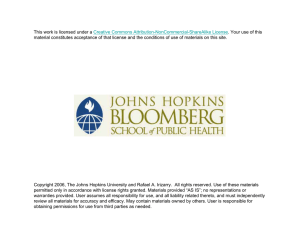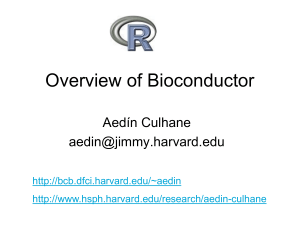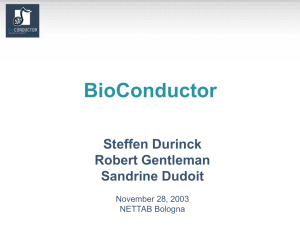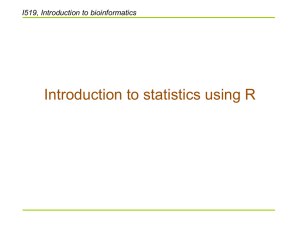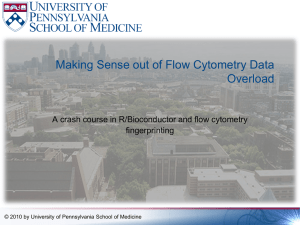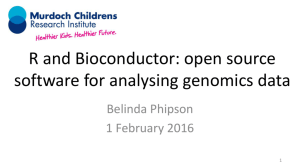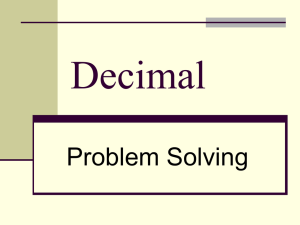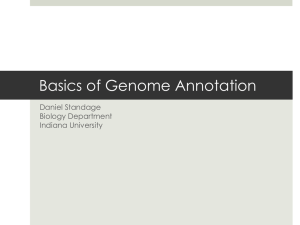BioCOverview2012
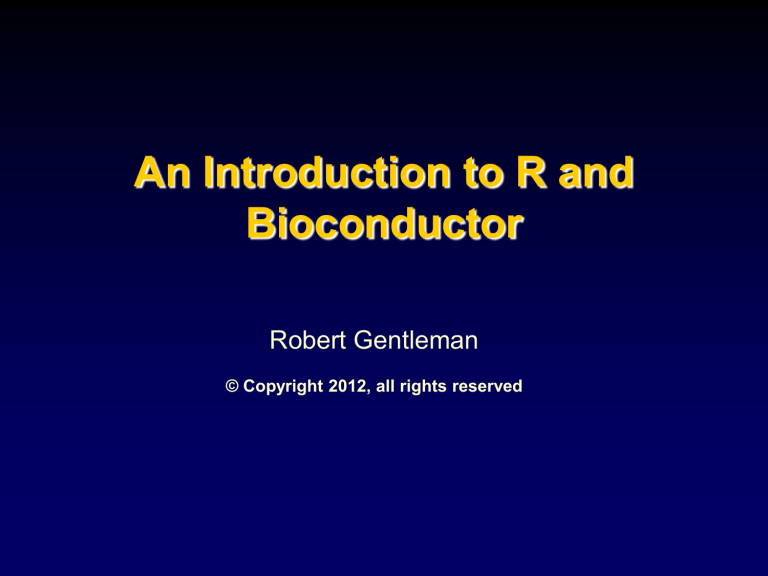
An Introduction to R and
Bioconductor
Robert Gentleman
© Copyright 2012, all rights reserved
The R Language
• R is a fully functional programming language and analysis environment for scientific computing
• it contains an essentially complete set of routines for numerical computations, statistical analysis and has extensive graphics capabilities
• computations/algorithms are organized by packages
(there are over 3000) and these can easily be downloaded and installed on your computer
• users can create and share their own packages
– two main repositories are CRAN and Bioconductor
– packages will contain source code, documentation etc
R Language
• R has a new release once per year with patch releases somewhat more often
– you should keep your local versions of R and Bioconductor up to date
• you should always use biocLite in the biocInstaller package for Bioconductor packages and install.packages
, or update.packages for R
– this will ensure you have compatible versions of software
• packages contain source code, documentation
– man pages with examples
– vignettes: self-contained runnable documents that describe how the code in the package can be used on an analysis problem
Bioconductor
• Bioconductor is an open source and open development software project for the analysis of biomedical and genomic data.
• The project was started in the Fall of 2001 and includes developers in many countries
• R and the R package system are used to design and distribute software.
• A goal of the project is to develop integrated and interoperable software modules to provide comprehensive software solutions to relevant problems.
• we largely achieve that goal by using common data structures
Why are we Open Source
• so that you can find out what algorithm is being used, and how it is being used
• so that you can modify these algorithms to try out new ideas or to accommodate local conditions or needs
• so you can read the code, find bugs, suggest improvements etc.
• so that they can be used as components
(potentially modified) in other peoples software
Overview
• biology is a computational science
• problems of data analysis, data generation, reproducibility require computational support and computational solutions
• we value code reuse
– many of the tasks have already been solved
– if we use those solutions we can put effort into new research
• well designed, self-describing data structures help us deal with complex data
Goals
• Provide access to powerful statistical and graphical methods for the analysis of genomic data.
• Facilitate the integration of biological metadata
( GenBank, GO, Entrez Gene, PubMed ) in the analysis of experimental data.
• Allow the rapid development of extensible, interoperable, and scalable software.
• Promote high-quality documentation and reproducible research.
• Provide training in computational and statistical methods.
Bioconductor packages
Release 2.10, 554 Software Packages!
• General infrastructure
Biobase , Biostrings, biocViews
• Annotation: annotate , annaffy , biomaRt , AnnotationDbi data packages.
•
Graphics/GUIs: geneplotter , hexbin, limmaGUI, exploRase
• Pre-processing: affy , affycomp, oligo, makecdfenv , vsn, gcrm, limma
• Differential gene expression: genefilter , limma , ROC, siggenes, EBArrays, factDesign
• GSEA/Hypergeometric Testing
GSEABase, Category, GOstats, topGO
• Graphs and networks: graph , RBGL , Rgraphviz
•
Flow Cytometry: flowCore, flowViz, flowUtils
• Protein Interactions: ppiData, ppiStats, ScISI, Rintact
• Sequence Data:
Biostrings,ShortRead,rtracklayer,IRanges,GenomicFeatures,
VariantAnnotation
•
Other data: xcms, DNAcopy, PROcess, aCGH, rsbml, SBMLR, Rdisop
Component software
• most interesting problems will require the coordinated application of many different techniques
• thus we need integrated interoperable software
• of primary importance is well designed and shared data structures
• you should design your contributions to be a cog in a big machine
Data complexity
• Dimensionality.
• Dynamic/evolving data: e.g., gene annotation, sequence, literature.
• Multiple data sources and locations: in-house, WWW.
• Multiple data types: numeric, textual, graphical.
No longer X nxp
!
We distinguish between biological metadata and experimental metadata.
Experimental metadata
• when were the samples processed and how
• what arrays were used/what kits
• if size selection of some sort (eg. fractionation for proteomics experiments) was used
• date the samples were run
• lane or chip information
• treatments
Biological metadata
• Biological attributes that can be applied to the experimental data.
• E.g. for genes
– chromosomal location;
– gene annotation (Entrez Gene, GO);
– gene models
– relevant literature (PubMed)
• Biological metadata sets are large, evolving rapidly, and typically distributed via the WWW.
• Tools: annotate , biomaRt , and
AnnotationDbi, GenomicFeatures packages, and annotation data packages.
Annotation packages
annotate , annafy, biomaRt , and AnnotationDbi
Metadata package hgu95av2 mappings between different gene IDs for this chip.
GENENAME zinc finger protein 261
ACCNUM
X95808
PMID
10486218
9205841
8817323
AffyID
41046_s_at
ENTREZID
9203
MAP
Xq13.1
SYMBOL
ZNF261
• Assemble and process genomic annotation data from public repositories.
• Build annotation data packages.
• Associate experimental data in real time to biological metadata from web databases such as
GenBank, GO, KEGG,
Entrez Gene, and PubMed.
• Process and store query results: e.g., search
PubMed abstracts.
• Generate HTML reports of analyses.
GO
GO:0003677
GO:0007275
GO:0016021 + many other mappings
Sequence Annotation
• for a given gene:
– gene models
– sequence
– exon/intron boundaries
– location
– conservation
• often in the form of tracks
• it is important to keep track of the reference genome being used
Vignettes
• Bioconductor developed a new documentation paradigm, the vignette.
• A vignette is an executable document consisting of a collection of documentation text and code chunks.
• Vignettes form dynamic , integrated , and reproducible statistical documents that can be automatically updated if either data or analyses are changed.
• Vignettes can be generated using the Sweave function from the R tools package.
Short Courses/Conferences
• we have given many short courses
– see bioconductor.org
for more details on upcoming courses
• BioC2012 - Seattle, July 24-25
• European Developers’ workshop
– Zurich, 13-14 December, 2012
Bioconductor Software
• concentrate development resources on a few important aspects
• Biobase: core classes and definitions that allow for succinct description and handling of the data
• annotate: generic functions for annotation that can be specialized
• genefilter/limma/DESeq/DEXSeq: differential expression
• ShortRead/IRanges/GenomicFeatures/Variant
Annotation : string manipulations, sequence analysis
Quality Assessment
• ensuring that the data are of sufficient quality is an essential first step
• arrayQuality Metrics : comprehensive
QA assessment of microarrays (one color or two color)
– modifications are coming to make it more suitable for sequence data
• ShortRead : tools for QA of short reads, primarily Illumina
Biobase:ExpressionSet
• software should help organize and manipulate your data
• the data need to be assembled correctly once, and then they can be processed, subset etc without worrying about them
• we developed the ExpressionSet class
• SummarizedExperiment class is the next iteration in this process (in the
GenomicRanges package)
Microarray data analysis
Pre-processing
CEL, CDF affy vsn
.gpr, .Spot
marray limma vsn
ExpressionSet
Differential expression edd genefilter limma multtest
ROC
+ CRAN
Graphs & networks graph
RBGL
Rgraphviz
Cluster analysis
CRAN class cluster
MASS mva
Prediction
CRAN class e1071 ipred
LogitBoost
MASS nnet randomForest rpart
Annotation annotate annaffy biomaRt
+ metadata packages
Graphics geneplotter hexbin
+ CRAN
Differential Expression
• limma : provides a linear models interface for DE
– uses a moderated variance
– a variety of p-value correction methods are provided
• DESeq and edgeR : for sequence data
– similar approach to limma
– make use of count data (Neg Binomial)
• DEXSeq for exon level differential expression
Machine Learning
• In R software for machine learning has been written by many different people
– the calling sequences and return values are unique to each method
• MLInterfaces
• provides uniform calling sequences and return values for all machine learning algorithms
• MLearn is the main wrapper function
– methods, eg knni, are passed to the wrapper
• return values are of class MLOutput
• see the MLInterfaces vignette for more details
Publications
• Bioconductor: Open software development for computational biology and bioinformatics ,
Genome Biology 2004, 5:R80, http://genomebiology.com/2004/5/10/R80
• Bioinformatics and Computational Biology
Solutions using R and Bioconductor , Springer,
2005, R. Gentleman, V. Carey, W. Huber, R.
Irizarry, S. Dudoit eds.
• Bioconductor Case Studies , Springer
• R Programming for Bioinformatics , Chapman
Hall
References
• R www.r-project.org
, cran.r-project.org
– software (CRAN);
– documentation;
– newsletter: R News;
– mailing list.
• Bioconductor www.bioconductor.org
– software, data, and documentation (vignettes);
– training materials from short courses;
– mailing list (please read the posting guide)
